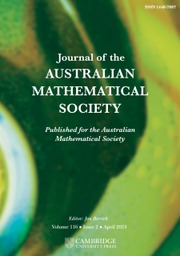No CrossRef data available.
Article contents
DIFFRACTION OF THE PRIMES AND OTHER SETS OF ZERO DENSITY
Published online by Cambridge University Press: 21 May 2025
Abstract
In this paper, we show that the diffraction of the primes is absolutely continuous, showing no bright spots (Bragg peaks). We introduce the notion of counting diffraction, extending the classical notion of (density) diffraction to sets of density zero. We develop the counting diffraction theory and give many examples of sets of zero density of all possible spectral types.
Keywords
Information
- Type
- Research Article
- Information
- Journal of the Australian Mathematical Society , Volume 119 , Issue 2 , October 2025 , pp. 202 - 245
- Copyright
- © The Author(s), 2025. Published by Cambridge University Press on behalf of Australian Mathematical Publishing Association Inc
Footnotes
Communicated by Michael Coons
The first author was partially supported by the NSERC Discovery grant 2024-03883, the second author was supported by the NSERC Discovery grant 2019-05430, and the third author was supported by the NSERC Discovery grants 2020-00038 and 2024-04853.
References
Baake, M., ‘Diffraction of weighted lattice subsets’, Canad. Math. Bull. 45 (2002), 483–498.CrossRefGoogle Scholar
Baake, M. and Grimm, U., Aperiodic Order. Volume 1: A Mathematical Invitation, Encyclopedia of Mathematics and its Applications, 149 (Cambridge University Press, Cambridge, 2013).CrossRefGoogle Scholar
Baake, M., Huck, C. and Strungaru, N., ‘On weak model sets of extremal density’, Indag. Math. (N.S.) 28 (2017), 3–31.Google Scholar
Baake, M. and Lenz, D., ‘Dynamical systems on translation bounded measures: pure point dynamical and diffraction spectra’, Ergodic Theory Dynam. Systems 24 (2004), 1867–1893.Google Scholar
Baake, M. and Moody, R. V., ‘Weighted Dirac combs with pure point diffraction’, J. reine angew. Math. 573 (2004), 61–94.Google Scholar
Bateman, P. and Stemmler, R., ‘Waring’s problem for algebraic number fields and primes of the form
 $({p}^r-1)/({p}^d-1)$
’, Illinois J. Math. 6 (1962), 142–156.CrossRefGoogle Scholar
$({p}^r-1)/({p}^d-1)$
’, Illinois J. Math. 6 (1962), 142–156.CrossRefGoogle Scholar
Berg, C. and Forst, G., Potential Theory on Locally Compact Abelian Groups (Springer, Berlin, 1975).Google Scholar
Dworkin, S., ‘Spectral theory and X-ray diffraction’, J. Math. Phys. 34 (1993), 2965–2967.Google Scholar
Gouéré, J.-B., ‘Diffraction and Palm measure of point processes’, C. R. Math. Acad. Sci. Paris 336 (2003), 57–62.Google Scholar
Grimm, U. and Deng, X., ‘Some comments on pinwheel tilings and their diffraction’, J. Phys.: Conf. Ser. 284 (2011), Article no. 012032.Google Scholar
Hof, A., ‘On diffraction by aperiodic structures’, Comm. Math. Phys. 169 (1995), 25–43.Google Scholar
Keller, G. and Richard, C., ‘Dynamics on the graph of the torus parametrisation’, Ergodic Theory Dynam. Systems 38 (2018), 1048–1085.CrossRefGoogle Scholar
Keller, G. and Richard, C., ‘Periods and factors of weak model sets’, Israel J. Math. 229 (2019), 85–132.Google Scholar
Maynard, J., ‘Small gaps between primes’, Ann. of Math. (2) 181 (2015), 383–413.CrossRefGoogle Scholar
Montgomery, H. L. and Vaughan, R. C., ‘The large sieve’, Mathematika 20 (1973), 119–134.CrossRefGoogle Scholar
Moody, R. V. and Strungaru, N., ‘Almost periodic measures and their Fourier transforms’, in: Aperiodic Order. Volume 2: Crystallography and Almost Periodicity, Encyclopedia of Mathematics and its Applications, 166 (eds. Baake, M. and Grimm, U.) (Cambridge University Press, Cambridge, 2017), 173–270.Google Scholar
Pedersen, G. K., Analysis Now (Springer, New York, 1989); revised printing 1995.CrossRefGoogle Scholar
Polymath, D. H. J., ‘Variants of the Selberg sieve, and bounded intervals containing many primes’, Res. Math. Sci. 1 (2014), 83 pages.CrossRefGoogle Scholar
Richard, C. and Strungaru, N., ‘Fourier analysis of measures with lattice support’, in preparation.Google Scholar
Samuel, , ‘What’s the asymptotic distribution of
 ${p}^n$
(powers of primes)?’, Mathstackexchange, q/396665, 2016. https://math.stackexchange.com/q/396665.Google Scholar
${p}^n$
(powers of primes)?’, Mathstackexchange, q/396665, 2016. https://math.stackexchange.com/q/396665.Google Scholar
Schlottmann, M., ‘Generalised model sets and dynamical systems’, in: Directions in Mathematical Quasicrystals, CRM Monograph Series, 13 (eds. Baake, M. and Moody, R. V.) (American Mathematical Society, Providence, RI, 2000), 143–159.Google Scholar
Strungaru, N., ‘On the Fourier analysis of measures with Meyer set support’, J. Funct. Anal. 278 (2020), Article no. 108404.CrossRefGoogle Scholar
Torquato, S., Zhang, G. and de Courcy-Ireland, M., ‘Hidden multiscale order in the primes’, J. Phys. A 52 (2018), Article no. 135002.Google Scholar
Torquato, S., Zhang, G. and de Courcy-Ireland, M., ‘Uncovering multiscale order in the prime numbers via scattering’, J. Stat. Mech. 2018 (2018), Article no. 093401.CrossRefGoogle Scholar
Zhang, G., Martelli, F. and Torquato, S., ‘The structure factor of primes’, J. Phys. A 51 (2018), Article no. 115001.CrossRefGoogle Scholar
Zhang, Y., ‘Bounded gaps between primes’, Ann. of Math. (2) 179 (2014), 1121–1174.CrossRefGoogle Scholar


